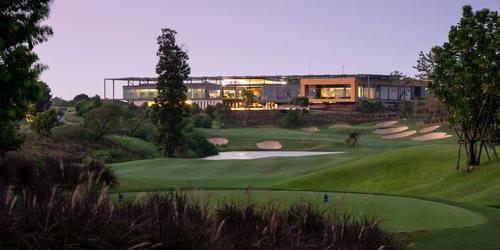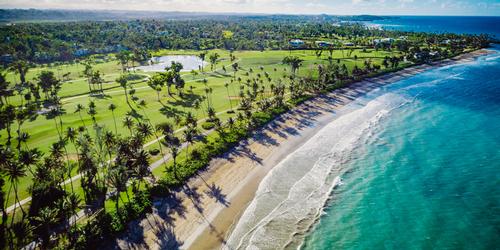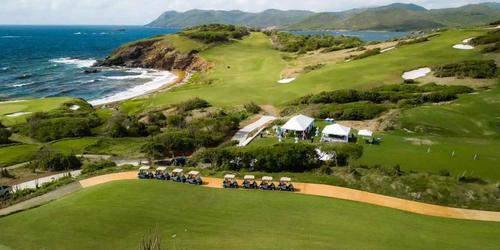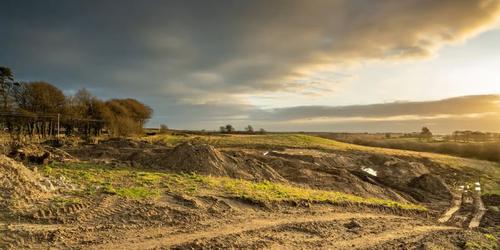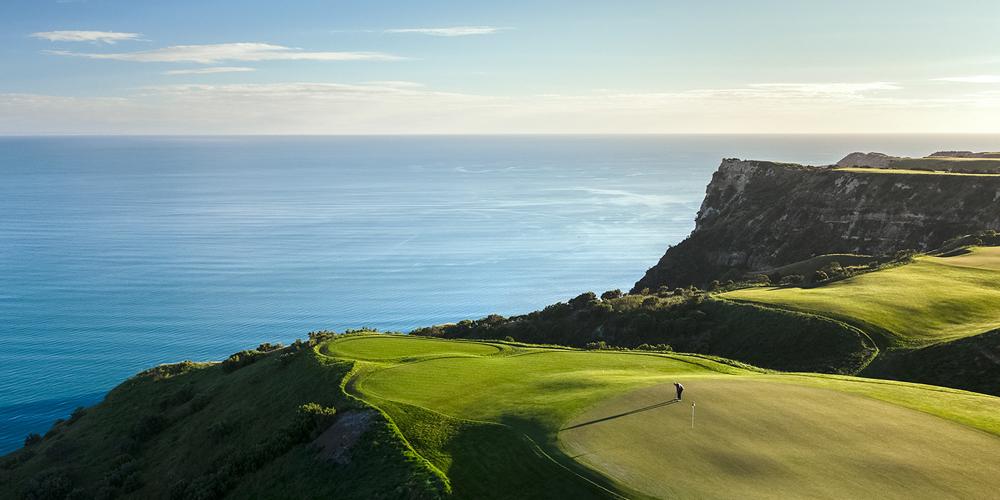
Zeal for Golf in New Zealand
By Jeff Thoreson
I've been to the end of the Earth, and damn if there isn't a golf course there. When you arrive at the 15th green at Cape Kidnappers in Hawke's Bay, New Zealand, you've reached the edge. You can go no farther. At the back of the green, the Earth drops straight down 600 feet to the Pacific Ocean, and there is nothing else to see.
Until the moment I arrived at this spot, I had acknowledged the seaside holes at Pebble Beach to be the pinnacle of oceanside golf. But now, standing on this spot staring out over the vastness of the ocean, I've come to the conclusion that I have to rethink my understanding of the golf world; perhaps the entire world. This spot at Cape Kidnappers, where land, sea and golf meet in such impossible perfection, you take in the as-far-as-the-eye-can-see view and contemplate the enormity of the world and golf's small place in it. Here, on this spot, you just have to wonder how it all got this way.
But then there's the closing stretch at Cape Kidnappers to contemplate. The drama of the course - the holes that cling to fingers of land edged by cliffs and canyons so steep and so deep that falling is not an option - is behind you. The closing holes are good ones, to be sure, but the whole course can't play at the end of the world, so on the 16th the course turns back toward safer territory.
There is more to the game than a weekend stroll around your home club, an annual trip to Myrtle Beach and an occasional jaunt to the links of the British Isles. The world is full of interesting cultures that have an affection for golf. We test this theory in New Zealand, land of Kiwi, which is at once a furry fruit, a flightless bird and a reference to the country's native population.
There are 400 courses on the two islands, which roughly equate to the U.S. East Coast from Boston to Miami. Auckland is about New York City, Wellington is Charleston, South Carolina, and on the south island, Christchurch is about Orlando. You can travel the entire country and never get farther from the ocean than Atlanta. The difference is the farther north you go the warmer it gets, and if you go to the tip of the south island, you are less than the width of the continental United States from Antarctica.
The golf from north to south is best described as at times so American you wonder why you flew halfway around the world to play, and at times so spectacular the thought of staying for another week or maybe another decade can't help but enter your mind.
Auckland is the business and cultural center of New Zealand's north island, and the country's port of entry for almost all of its international guests. The 30-minute drive from the airport to the city center isn't really distinguishable from the same drive in any American city other than you're driving on the wrong side of the road. Parkways exit onto streets heavy with traffic lights and there is plenty of activity well into the night.
Auckland and New Zealand's other major cities are thick with golf courses. The country has more per capita than almost any other country. In the Auckland area, the modern Gulf Harbour, about 35 minutes north of the Auckland Harbour Bridge on the Whangaparaoa Peninsula is the best, with the tempting ocean side dogleg-right 16th daring you to cut off more of the ocean than you can. It's a great hole, but not one that will drag you down under and across the International Date Line on an overnight flight to play, even though it's a fine Robert Trent Jones Jr. design that offers glimpses of the Auckland skyline from a couple tees on the back nine. New Zealand's marquee courses require some in-country travel.
Two Kiwi Cliffhangers
Cape Kidnappers
Right now, I'm wishing golf hadn't been so hasty in moving away from metal spikes. My ball has come to rest a few feet to the left of the par-3 sixth green at Cape Kidnappers, which means it's just a few feet to the right of a cliff that plummets down to the Pacific and, with the wind blowing out to sea, a little more traction would be a good thing. As I close in on the ball I'm thinking it might be wise just to take an unplayable lie, even though the ball is sitting perfectly fine just off the fringe. It's that close to the edge, and the angle of the terrain and the unencumbered wind don't look like a good combination. I creep to the edge and see a large grassy ledge five or six feet below the corner of the Earth my ball is clinging to; it's sort of a buffer between golf and death. So then I think if I jump off I could scare the crap out of the three guys I'm traveling with. I play the shot and actually save par. But that's just the first encounter with cliff side golf at Cape Kidnappers where you might think of golf in Barnum and Bailey terms: death defying.
Fairways nudge to the edge of crevasses so steep that if you survived the fall, which you wouldn't, you couldn't possibly climb back up. Greens are pushed to the very edge of available real estate, and the whole setting is so far from any mainstream concept of a golf setting that it has to be - almost by definition - one of the world's great courses.
If you're at all interested in the wide world of golf, you've probably seen pictures of Cape Kidnappers, and if you've seen those fingery spines of cliff-top green fairways you would think it wise to load up on ammo before doing battle with the Cape. You wonder how many balls you will need. Four? Six? A full dozen? You figure you can easily lose that many pellets over the edge in a single round. Believe it or not, it's actually hard to send a ball into oblivion here. It's easier to launch a tee shot into a cow pasture on the Cape's working farm (which, incidentally, is not out of bounds but requires careful steps) than over a cliff.
Even those pictures don't adequately prepare you for the experience. When you get to the edge, you are simply blown away.
Kauri Cliffs
In the pencil holder on the reception desk at Kauri Cliffs are 14 pencils, each exactly the same height and sharpened to exactly the same point, except one. Its point is worn to a nub. It's dirty from so many fingerprints. So you wonder when someone will notice and take the scoundrel out back, wash behind its ears, polish it up, return its point to the standard of the others and replace it in the holder - or just get rid of it all together. After a few days at Kauri Cliffs, you come to expect that level of attention to detail, which is why you notice the renegade pencil in the first place.
As great and pricy as the Kauri Cliffs resort is - and you absolutely have to include it on your itinerary - you get a better feel for the essence of the New Zealand Northlands by staying in a small oceanfront hotel in Paihia, or a B&B in Kerikeri and hanging out at the local restaurants and bars.
The Kauri Cliffs course is almost as spectacular as Cape Kidnappers. You can see the ocean from 15 holes and several holes hang on a cliff side that looks out over the spectacular Bay of Islands. On a clear day one could easily argue that New Zealand's two most dramatic courses are better than any two that any other country could put up for consideration.
If you don't agree, you have to stand on the spectacular seventh tee box of the cliff-hanging, long-iron par 3. The rock outcroppings of the Bay of Islands poke up through the vast Pacific Ocean to your right, dragging your attention away from the considerable task at hand. Or crest the hill between the 13th green and 14th tee and play the next four holes with the same view to the left and tell me what is comparable.
The first three holes of the back nine sit in a crevasse out of view of the ocean. But the rest of the holes have clear views, although sometimes you have to look behind you, which is fine because you don't want to miss anything.
More in the North
Northland is New Zealand's beach setting, with small resort towns and the Bay of Islands. While the golf is an eye full of stunning scenery, you can catch glimpses of New Zealand's natural beauty along walking trails that take you past places like Haruru Falls on the Waitangi River or up to Paihia Lookout in the highlands overlooking the Bay of Islands.
Golf centers around Kauri Cliffs, but there is more to discover. Carrington Resort is New Zealand's northernmost resort and the course resides on a stunning piece of seaside land, and while the length (7,100 yards) and sea breezes combine to present a formidable challenge, the beauty and wonderfully strategic par fours hold your interest throughout the round.
The course is pinched by Carrington Farms, a 300-head Black Angus cattle farm, and the 100-acre Karikari Vineyard, so expect a good steak and a fine bottle of wine for dinner.
Waitangi Golf Course overlooks the Bay of Islands near the resort towns of Paihia, Kerikeri and Russell. The constant change of views from the Bay of Islands to river and estuary views over Waitangi and Opua to rolling bush and forest views inland over Mount Bledisloe and Puketona keep the golf interesting. There is nothing more refreshing than making the turn on a hot summer day and taking in the wonderful sea views and feeling that welcome sea breeze.
Steaming Hot at Lake Taupo
Lake Taupo is where Aucklanders go to vacation. Less than four hours south of the capital city, the Taupo Volcanic Zone is a setting of steaming cliffs, geysers, boiling lakes, bubbling mud pools and floating rocks called pumice. Orakei Korako is one of the best thermal areas left in the world and you can make the three-hour trek up the side of the volcanic slope of Mount Ngaruahoe and peek inside the active crater. Or take a bungee dive near Huka Falls. After, of course, a night or two (at least) at the opulent Huka Lodge, consistently voted by any source of world-class hotels as one of the planet's best accommodations.
But don't miss the golf at Wairakei International, New Zealand's first internationally recognized course. Designed by Australian Peter Thomson in the early 1970s, Wairakei remains the north island's third course to appear on lists of the greatest international courses.
The course pays tribute to New Zealand's heritage with hole names drawn from the Maori language and its setting in New Zealand's volcanic region, where mountains push up abruptly from the ground, creates some dramatic shots, like the sharply downhill tee shot to a mountain backdrop on the par-4 sixth.
Nearby Kinloch Golf Club has a Scottish name for good reason. Jack Nicklaus built a rugged links-style course on a rough piece of land just 25 minutes from beautiful and serene Lake Taupo. It is unlike anything else in New Zealand.
The Rise of the South
New Zealand golf writer Brendan James describes it this way: "If the North Island is the land of fire and steam (with its volcanoes and thermals), the South Island is certainly the land of water and ice. Ice ages, fault lines and tectonic plate movements have all made their mark on New Zealand, especially the South Island, which is home to the majestic Southern Alps, a network of fiords and several glaciers that continue to march down into rainforest."
It would be easy to argue that the South Island is more scenic, but the layouts at Cape Kidnappers and Kauri Cliffs probably give the North Island the nod in golf. Nevertheless, the South Island is where golf in the country began. Christchurch and Queenstown are both cities worth traveling to on their own, but there is quality golf with spectacular scenery.
Jack's Point is just five minutes from the airport in Queenstown. The course is often mentioned along with Kidnappers and Kauri as NZ's most awesome. It sits between The Remarkables mountain range and the cliff tops above Lake Wakatipu. Millbrook Resort is nestled in the stunning landscape of the film trilogy The Lord of the Rings, though the terrain of the course is not nearly as rugged.
Queenstown's reputation as a year-round playground for the adventurous is well deserved. You can bungee jump, skydive, climb a mountain, hike a glacier or take a hot air balloon ride through the mountains.
Christchurch is the heart of the South Island. To the north are hot pools, vineyards and oceanic wildlife encounters. A journey west requires a train trip over the Southern Alps to discover rainforests and glaciers. South is the island's beautiful high country and home to Mount Cook, New Zealand's tallest mountain. Known as the Garden City, Christchurch offers access to great surfing in the summer and great skiing in the winter. The golf is great for three seasons each year.
Stay for a while and travel to natural wonders like the West Coast glaciers and Aoraki Mt Cook National Park. Sample delicious food and wine and enjoy the down-under style of southern hospitality.
Terrace Downs is just over an hour from downtown Christchurch and is home to some of the most spectacular mountain views from a golf course anywhere in the world. Clearwater Resort is known for its water features, even though none is the ocean.
If you're going to travel halfway around the world to visit New Zealand, there's no sense not seeing the entire country. The North Island has the oceanscape views of Cape Kidnappers and Kauri Cliffs, but the South has mountainscapes, with golf being played beneath snow-peaked ranges at times.
Revised: 01/18/2021 - Article Viewed 7,179 Times
About: Jeff Thoreson
![]() Jeff Thoreson is a Washington, D.C.-based golf and travel writer. He has played many of the great courses of the world but finds great pleasure in traveling to out-of-the-way places to find true hidden gems.
Jeff Thoreson is a Washington, D.C.-based golf and travel writer. He has played many of the great courses of the world but finds great pleasure in traveling to out-of-the-way places to find true hidden gems.





